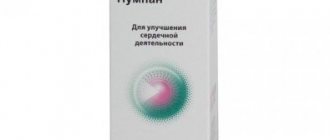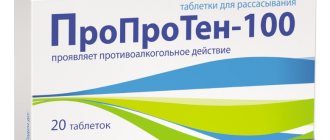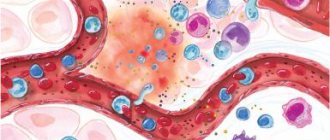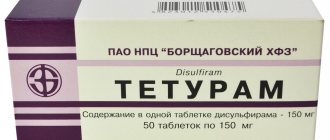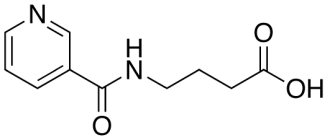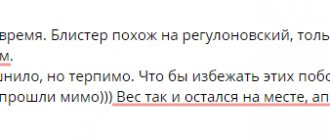Release form and composition
"Rupafine" are round, pinkish tablets. The main active ingredient is rupatadine fumarate. Additionally, substances such as pregelatinized starch, lactose monohydrate, microcrystalline cellulose, yellow iron oxide dye, and magnesium stearate are used. The medicine is offered in pharmacies in cardboard packaging.
Rupafin tablets belong to the second generation of antihistamines. The main active ingredient plays the role of a long-acting blocker of peripheral histamine receptors. The release of histamine is key in the manifestation of various types of urticaria, as well as allergic rhinitis. Therefore, the drug “Rupafin” has mostly positive reviews from doctors. Experts note that the medicine helps cope with mild allergic reactions.
pharmachologic effect
Antiallergic agent - H1-histamine receptor blocker.
Rupatadine belongs to the second generation of antihistamines and is a long-acting and selective blocker of peripheral H1-histamine receptors. Some of its metabolites (desloratadine and 3-hydroxydesloratadine) retain antihistamine activity and may contribute to the overall effectiveness of the drug.
Due to the selectivity of rupatadine for peripheral H1-histamine receptors, it does not have a significant effect on the activity of the central nervous system (CNS) at doses of 10 or 20 mg/day.
Since histamine release is a key factor in the pathogenesis of all types of urticaria, it is expected that when rupatadine is prescribed in accordance with clinical recommendations, it will be able to effectively reduce the severity of symptoms not only of chronic idiopathic urticaria, but also of other types of urticaria.
Indications
You should consult your doctor before taking Rupafin tablets. The instructions state that the medication is suitable for eliminating allergy symptoms, which manifest themselves in the form of urticaria or rhinitis. Most often, this reaction is observed in sensitive people upon contact with certain types of plants or citrus fruits. It is not recommended to take the medication on your own. Although it can be sold in pharmacies without a prescription. The problem is that the patient cannot independently find out the nature of the occurrence of a particular reaction. Often, allergy sufferers attribute rhinitis to their sensitivity and begin treatment with antihistamines. Although the disease can be viral in nature.
Rupafin tablets have an age limit. The instructions for use state that the medicine can be prescribed for the treatment of allergies in patients over 12 years of age. If unpleasant symptoms occur in a young child, you should consult a doctor.
Contraindications
People suffering from chronic diseases should take Rupafin with caution. Reviews from doctors show that the medicine is contraindicated in chronic renal failure, liver failure, and diabetes. The drug is strictly prohibited for people with hereditary galactose intolerance, as well as lactase deficiency. In rare cases, hypersensitivity to elements of the drug may occur.
Patients over 65 years of age should take the tablets under medical supervision. People with cardiovascular problems are at risk. Women should not take antihistamines during pregnancy and lactation. This is due to the possible absorption of drug components into the blood. The effects of rupadanine on the fetus have not previously been studied.
special instructions
People who work in responsible positions should take Rupafin tablets correctly. The instructions for use state that in the correct dosage the medication does not affect the ability to drive vehicles and complex mechanisms. Experts still note that many patients experience drowsiness. Therefore, you should not take pills before an important event or transaction.
The tablets are taken with plenty of liquid. But it is not recommended to take the medicine with citrus juice. Taking the medication together with grapefruit juice may lead to side effects. It is optimal to take the medicine with plenty of warm water.
Tablets Rupafin 10 mg summary (instructions for use) of the drug in photographs
Photo instructions for use of rupafin 10 mg tablets, part 1
Photo instructions for use of rupafin 10 mg tablets, part 2
Dosage and overdose
The medicine can be taken orally at any time of the day and regardless of meals. The recommended dose is 10 mg per female (1 tablet). The duration of treatment with Rupafin may depend on various factors. The instructions for use do not indicate any restrictions. The tablets are usually taken when allergy symptoms begin to appear. Most often, a few days of treatment are enough for rhinitis or urticaria to disappear completely.
Studies have been conducted to study how patients respond to drug overdose. Patients took 100 mg of the drug for a week. No serious side effects were observed. Patients noted only increased drowsiness, which prevented them from fully performing daily duties.
If the patient has taken a medicine in a dosage exceeding 100 mg, gastric lavage should be performed to avoid the development of serious side effects. It is better to do this in a hospital setting. Next, treatment continues with activated carbon. The patient must remain under the supervision of specialists for several more days and undergo all necessary tests.
Rupafin
Second generation histamine H1 receptor blocker. Selectively acts on peripheral histamine H1 receptors. Some of its metabolites (desloratadine and 3-hydroxydesloratadine) retain antihistamine activity and may contribute to the overall effectiveness of rupatadine.
Rupatadine exhibits high affinity for H1-histamine receptors. In vitro studies of rupatadine at high concentrations have shown inhibition of mast cell degranulation induced by immunological and non-immunological stimuli, suppression of eosinophil and neutrophil chemotaxis, and cytokine release (interleukin (IL)-5, IL-6, IL-8, GM-CSF ( granulocyte-macrophage colony-stimulating factor)), in particular TNF-α from human mast cells and monocytes. In addition, rupatadine caused a dose-dependent suppression of the expression of neutrophil adhesion molecules.
Due to the selectivity of rupatadine for peripheral histamine H1 receptors, it does not have a significant effect on the central nervous system at doses of 10 or 20 mg/day.
Pharmacokinetics
Rupatadine is rapidly absorbed after oral administration, the time to reach Cmax is approximately 0.75 hours. The average Cmax is 2.6 ng/ml after a single oral dose of 10 mg rupatadine and 4.6 ng/ml after a single oral dose of 20 mg rupatadine. The pharmacokinetics of rupatadine is linear for doses from 10 to 40 mg.
After taking 10 mg 1 time/day for 7 days, the average Cmax is 3.8 ng/ml. Plasma concentration decreases along a biexponential curve with an average T1/2 of 5.9 hours. The binding coefficient of rupatadine to plasma proteins is 98.5-99%. Since rupatadine has never been used intravenously in humans, there is no data on its absolute bioavailability.
Eating increases the overall effect of rupatadine on the body (AUC increases by approximately 23%). The effect on one of its active metabolites and on the main inactive metabolite is almost the same (approximately 5% and 3% reduction, respectively). The time required to achieve Cmax of rupatadine was extended by 1 hour. Cmax in plasma did not change as a result of simultaneous administration with food. These differences were not clinically significant.
Rupatadine undergoes significant first-pass metabolism when administered orally. Unchanged active substance is found in urine and feces only in small quantities. This means that rupatadine is almost completely metabolized. In vitro metabolism studies in human liver microsomes indicate that rupatadine is metabolized primarily by CYP3A4).
An excretion study in humans (40 mg of 14C-rupatadine) found that 34.6% of the drug was excreted by the kidneys and 60.9% through the intestines within 7 days. The average T1/2 is 5.9 hours.
In a study in healthy volunteers, comparing results obtained in young and elderly subjects, the AUC and Cmax values for rupatadine were higher in older subjects. This is likely due to decreased hepatic first-pass metabolism in older adults. These differences were noted only for rupatadine and not for its metabolites. The average T1/2 of rupatadine in elderly and young volunteers was 8.7 hours and 5.9 hours, respectively. The results for rupatadine and its metabolites were not clinically significant.
Side effects
Patients usually tolerate Rupafin well. Reviews show that adverse reactions develop only in 10% of cases. Most often, the symptoms are reversible and do not require discontinuation of the medication. Most patients develop drowsiness or headache. In some cases, dizziness occurs. Adverse reactions from the respiratory system may occur. Patients may experience nosebleeds or dry mucous membranes. Pharyngitis and sore throat develop less frequently.
2% of patients who took part in the study experienced disorders of the digestive system. They manifested themselves in the form of nausea, vomiting and diarrhea. If such symptoms occur when using allergy pills, Rupafin should be discontinued. There are many other antihistamines that perfectly relieve allergic reactions.
Some patients exhibit hypersensitivity to rimantadine. It manifests itself in the form of swelling of the limbs and rash. If we consider that Rupafin tablets are prescribed to eliminate the same symptoms, there is no need to use them.
Side effects
The most common symptoms observed when using the drug were fatigue, headache, and drowsiness (in 3.2%, 6.9% and 9.5% of patients, respectively). As a rule, in these cases, discontinuation of the drug was not required.
During therapy with Rupafin, the following undesirable effects may also be observed:
- Respiratory system: uncommon - dry throat, cough, pharyngitis, dry nasal mucosa, rhinitis, nosebleeds, pain in the pharynx and larynx;
- Nervous system: often – asthenia, dizziness; infrequently – irritability, decreased concentration;
- Digestive system: often – dry mouth; uncommon – vomiting, dyspepsia, diarrhea, nausea, constipation, abdominal pain;
- Metabolism and nutrition: infrequently – increased appetite;
- Musculoskeletal system: uncommon – myalgia, arthralgia, back pain;
- Skin: uncommon – rash;
- Changes in laboratory parameters: increased alanine aminotransferase (ALT), creatine phosphokinase (CPK), aspartate aminotransferase (AST), abnormal liver function tests;
- General disorders: weight gain, fever, malaise, thirst.
No cases of overdose have been reported. During clinical safety studies of rupatadine, it was well tolerated at a dose of 100 mg per day for 6 days. The most common side effect of the drug in case of overdose is drowsiness.
When using excessively high doses of Rupafin, it is recommended to induce vomiting and then take activated charcoal. If these measures are ineffective, gastric lavage with 0.9% sodium chloride solution is prescribed.
Drug interactions
Rupafin tablets should be taken with caution with other medications. The instructions for use indicate that ketoconazole at a dose of 20 mg can increase the effect of rupadanine by 10 times. For this reason, ketoconazole-based drugs are not recommended to be taken together with antihistamine tablets. Adverse reactions such as excessive drowsiness and dizziness may develop.
Grapefruit juice also enhances the effect of the main substance of the drug. Therefore, taking tablets with this product is strictly prohibited. During treatment with an antihistamine, it is generally recommended to avoid consuming acidic foods.
Rupatanin, together with ethanol, has a strong effect on the functioning of the central nervous system. For this reason, you should avoid drinking alcohol during allergy treatment. You should take ethanol-based medications with caution. If there is a need to combine individual medications, you should adhere to the time interval.
Rupafin side effects
The most commonly reported adverse drug reactions in patients receiving rupatadine were drowsiness, headache, and fatigue, occurring in 9.5%, 6.9%, and 3.2% of patients, respectively. In most cases, discontinuation of the drug was not required.
Classification of adverse reactions by frequency of development (number of registered cases / number of patients): very common - more than 1 in 10 cases often - from 1 in 10 to 1 in 100 cases infrequently - from 1 in 1000 to 1 in 100 cases.
From the nervous system:
Common: drowsiness, headache, dizziness, fatigue, asthenia.
Uncommon: decreased concentration, irritability.
From the respiratory system, chest and mediastinal organs:
Uncommon: nosebleeds, dry nasal mucosa, pharyngitis, cough, dry throat, pain in the pharynx and larynx, rhinitis.
From the gastrointestinal tract:
Common: dry mouth.
Uncommon: nausea, diarrhea, dyspepsia, vomiting, abdominal pain, constipation.
Metabolism and nutrition:
Uncommon: increased appetite.
For the skin and subcutaneous tissues:
Uncommon: rash.
From the musculoskeletal and connective tissue side:
Uncommon: back pain, arthralgia, myalgia.
Common disorders:
Uncommon: thirst, malaise, fever, weight gain.
Changes in laboratory parameters:
Uncommon: increased creatine phosphokinase, alanine aminotransferase, aspartate aminotransferase; changes in liver function test parameters.
Overdose
There are no cases of drug overdose described in the literature. In a clinical safety study, rupatadine was well tolerated at a daily dose of 100 mg for 6 days. The most common adverse reaction is drowsiness.
In case of accidental ingestion of very high doses of the drug, it is recommended to induce vomiting in the patient followed by administration of activated charcoal.
If this manipulation turns out to be impossible or ineffective, it is necessary to rinse the stomach with isotonic sodium chloride solution.
Interaction with other drugs
Interaction with ketoconazole and erythromycin
The combined use of rupatadine at a dose of 20 mg and ketoconazole or erythromycin increases the systemic effect of rupatadine by 10 times and the latter by 2-3 times. These combinations are not accompanied by changes in the QT interval or an increase in the frequency of adverse reactions compared to the separate use of these drugs.
However, rupatadine should be used with caution in combination with these drugs and other inhibitors of the CYP3A4 isoenzyme.
Interaction with grapefruit juice
Simultaneous administration of rupatadine and grapefruit juice increases the overall effect of rupatadine by 3.5 times. You should not drink grapefruit juice at the same time as taking the drug. Interaction with alcohol
When used simultaneously with alcohol, rupatadine at a dose of 10 mg does not cause more pronounced changes in cognitive and psychomotor activity compared to taking alcohol alone. A dose of 20 mg enhances changes caused by alcohol intake. Interaction with drugs that depress the central nervous system
The possibility of interaction of rupatadine with other antihistamines and CNS depressants cannot be excluded.
Interaction with statins
Due to the fact that some of the statins, like rupatadine, are metabolized by the CYP3A4 isoenzyme of cytochrome P450, the possibility of an increase in the level of creatinine phosphokinase when used together cannot be ruled out. For these reasons, rupatadine should be used with caution concomitantly with statins.
Special instructions During treatment with the drug, it is not recommended to take ethanol.
Effect on the ability to drive a car and other mechanisms When using the drug at a dose of 10 mg, no effect on the ability to drive a car or other mechanisms was noted. At the same time, there are reports of drowsiness noted during treatment with Rupafin.
In this regard, it is recommended to exercise caution when driving a car or engaging in other potentially hazardous activities that require increased concentration and speed of psychomotor reactions until the patient’s individual response to rupatadine is established.
Release form
Tablets 10 mg.
7 tablets in a PVC/PVDC/Al blister. 1 or 2 blisters along with instructions for use in a cardboard box.
10 tablets in PVC/PVDC/Al blister. 1 blister along with instructions for use in a cardboard box.
Photo of a blister of rupafin 10 mg tablets (front view)
Photo of a blister of rupafin 10 mg tablets (back view)
Best before date
3 years. Do not use after the expiration date stated on the package.
Photo of the packaging of rupafin 10 mg tablets, where the expiration date is indicated
Storage conditions
In a dry place, protected from light, at a temperature not exceeding 25 ° C. Keep out of the reach of children!
Conditions for dispensing from pharmacies
Without a doctor's prescription
Photo of the packaging of rupafin 10 mg tablets, where the price is indicated
Name and address of the manufacturer
X. Uriah and S.A. Sia.
Legal address:
Avenida Cami Real, 51-57 08184 Palau Solita and Plegamance, Barcelona, Spain
Actual address:
Avenida Cami Real, 51-57
Industrial area Riera de Calders 08184 Papau Solita and Plegamance, Barcelona, Spain
Quality complaints should be sent to:
Abbott Laboratories LLC 125171, Moscow, Leningradskoe shosse, building 16 a, building 1, business Tel.: +7 (495) 258 42 80 Fax
Analogs
What to do if you were unable to purchase Rupafin tablets at the pharmacy? A doctor can always recommend analogues. There are a huge number of antihistamines, which differ not only in their positive effects on the body, but also in their affordable price. For example, Diazolin tablets are popular. This drug has not only an antiallergic, but also a sedative effect. The tablets perfectly relieve hives, rhinitis, rashes and itching.
The drug is contraindicated for use during pregnancy and lactation. But in childhood the medicine can be used. The main thing is to follow the correct dosage. Children under two years of age should take no more than 50 mg per day. The daily dosage for an adult can be 200 mg.
The medicine has many contraindications, like the Rupafin tablets. Analogues should be taken only after consultation with a doctor. People with stomach ulcers, diabetes mellitus, closed-angle glaucoma, heart rhythm disorders, and epilepsy are prohibited from taking Diazolin tablets.
Folk remedies against allergies
In folk medicine, there are many methods that allow you to quickly get rid of allergy symptoms. You should not rely on them completely. But such recipes can be used as an auxiliary therapy in conjunction with Rupafin tablets. Patient reviews show that the treatment is much more effective. A recipe based on duckweed is popular. The fresh plant is poured with hot boiled water and infused for 24 hours. For half a liter of water you need 200 g of grass. The finished tincture is consumed one tablespoon three times a day.
Calendula also shows good results. If you wipe the hives with an alcohol solution, traces of allergies quickly go away. Calendula tincture with water can be taken internally. 10 g of dry leaves are poured into 100 g of boiled water. The medicine must be infused for 3 hours. Next, the tincture is taken several times a day.
Rupafin in Moscow
Absorption and bioavailability
Rupatadine is rapidly absorbed after oral administration; the time to reach maximum plasma concentration (TCmax) is approximately 0.75 hours. The average maximum plasma concentration (Cmax) is 2.6 ng/ml after a single oral dose of 10 mg and 4.6 ng/ml after a single oral dose of 20 mg rupatadine. The pharmacokinetics of rupatadine in the dose range from 10 mg to 20 mg is linear with single and multiple doses of the drug. After taking a dose of 10 mg once daily for 7 days, the average Cmax is 3.8 ng/ml. Plasma concentrations decrease along a biexponential curve; the average half-life (T1/2) is 5.9 hours. The binding of rupatadine to plasma proteins is 98.5–99%.
Since rupatadine has never been used intravenously in humans, there is no data on its absolute bioavailability.
Impact of food intake
Eating increases the systemic effect of rupatadine on the body (AUC - area under the pharmaceutical concentration-time curve) by approximately 23%. The effect of food on one of its active metabolites and on the main inactive metabolite is almost the same (a decrease of approximately 5% and 3%, respectively). TCmax of rupatadine was extended by 1 hour. The Cmax indicator did not change as a result of food intake. These differences were not clinically significant.
Metabolism and excretion
An excretion study in humans (labeled 14C-rupatadine, 40 mg) found that 34.6% of the drug was excreted by the kidneys and 60.9% by the intestines within 7 days. Rupatadine undergoes significant first-pass metabolism when administered orally. The amount of unchanged active substance in urine and feces was insignificant. This means that rupatadine is almost completely metabolized. Active metabolites, such as desloratadine and other hydroxylated derivatives, accounted for 27% and 48% of the systemic exposure of the active substances, respectively. In vitro metabolism studies
conducted on human liver microsomes show that rupatadine is metabolized primarily through the cytochrome P450 system (CYP3A4 isoenzyme).
Special patient groups
In a study in healthy volunteers, comparing results obtained in young and elderly subjects, the AUC and Cmax values for rupatadine were higher in older subjects. This is likely due to decreased hepatic first-pass metabolism in elderly patients. These differences were noted only for rupatadine and not for its metabolites. The mean T1/2 of rupatadine in elderly and young patients was 8.7 hours and 5.9 hours, respectively. Because the results for rupatadine and its metabolites were not clinically significant, it was concluded that no dose adjustment is required when the drug is administered to elderly patients at a dose of 10 mg.
Reviews of the drug "Rupafin"
The medication shows really good results in the treatment of allergies. Therefore, you can hear mostly positive reviews about it. Experts note that the medicine should be used to eliminate mild allergy symptoms such as urticaria or rhinitis. Tablets are not able to eliminate swelling or skin rashes. Other potent agents are used for this purpose.
Negative reviews are most often associated with improper use of the drug. Patients note that headaches and excessive drowsiness may occur. At the same time, they forget that the drug is not recommended to be taken together with other medications.
I am pleased with the cost of the drug “Rupafin”. The price of a small package (7 tablets) does not exceed 250 rubles. You can save money if you purchase a large package (14 tablets). Its cost in pharmacies is only 400 rubles.
Let's sum it up
An allergy is a reaction to a specific irritant. To avoid unpleasant symptoms, you must try to avoid objects that cause the development of hives or rhinitis. If an allergy does occur, Rupafin tablets will come to the rescue. Instructions, price - all this can be checked at the pharmacy with a pharmacist. It is still better to use the drug as prescribed by a specialist.
The medicine is available without a prescription. You can purchase the drug “Rupafin” in almost any pharmacy. Its price does not exceed 300 rubles.


